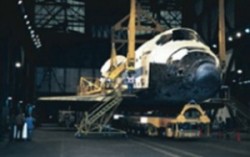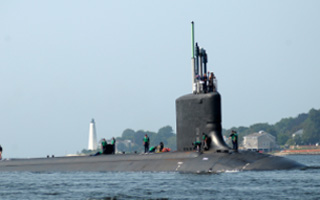Aurora Intelligent Scheduling of Maintenance, Repair, and Overhaul Operations
Maintenance, repair, and overhaul (MRO) are among the most challenging operations to schedule. Because the operating history and condition of each vehicle is unique, the MRO activities required by each vehicle can vary dramatically. Unexpected problems are often discovered, so schedules must be revised frequently to include additional MRO tasks.
For over two decades, the Aurora intelligent scheduling system has helped organizations manage their most complex and demanding fleet maintenance operations. Aurora is the world’s leading planning and scheduling software solution that applies artificial intelligence to solve complex scheduling problems — quickly and efficiently – by combining the hard-won knowledge of expert schedulers with Aurora’s sophisticated algorithms.
Aurora was originally developed to help NASA tackle difficult, mission-critical scheduling problems, such as the preparation and refurbishment of the Space Shuttle before and after each flight. Today, Aurora manages the most demanding operations for organizations like The Boeing Company, Mitsubishi Heavy Industries, Bombardier Learjet, Spirit Aerosystems, General Dynamics Electric Boat, Mitsubishi Heavy Industries, Korea Aerospace Industries, US Air Force, and US Navy.
For this section-based didactic schedule, the primary concerns are that sub-sections are not double-booked (e.g. small section A1A has an experience at the same time that large section A has a lecture, since the same students are in both, this situation would be a problem); that all atomic sections (the smallest unit) receive the same set of experiences as the other sections; and that the experiences have the necessary room allocations.
Aurora/AMP, in service for 18 years at NASA’s Kennedy Space Center, generated short- and long-term (10 year) schedules of ground based activities that prepared and refurbished Space Shuttles before and after each flight. Rapid scheduling enabled NASA to analyze numerous what-if scendarios efficiently. Aurora/AMP was used until the final space shuttle program concluded. Read our Aurora/AMP success story. Read our Boeing Success Story
For this section-based didactic schedule, the primary concerns are that sub-sections are not double-booked (e.g. small section A1A has an experience at the same time that large section A has a lecture, since the same students are in both, this situation would be a problem); that all atomic sections (the smallest unit) receive the same set of experiences as the other sections; and that the experiences have the necessary room allocations.
The Boeing Company uses Aurora to prioritize production ofthe Boeing 787 Dreamliner™. Aurora’s dynamic assembly schedule adapts to real-time production variations, so Boeing can produce aircraft as efficiently as possible. Read our Boeing Success Story
Aurora Outperforms Conventional Software
because it uses artificial intelligence technologies to encode and apply extensive scheduling knowledge and decision rules to generate more efficient schedules. For example, in a study conducted by The Boeing Company, Aurora managed resources more efficiently than software that Boeing had developed specifically for managing their own operations and had updated for almost two decades. Compared to Primavera, Aurora reduces turnaround time by 20%. Compared to Microsoft Project, Aurora’s schedules are 30% shorter.
Most other scheduling systems use simple rules to select and schedule tasks and assign resources to carry them out. These rules usually consider only limited information about the required tasks, resources, and constraints, so the generated schedules are far from optimal.
Some other systems rely on mathematical optimization to search systematically for the best scheduling solution. However, as the number of scheduled tasks and constraints grows, the computer time needed to solve the problem grows exponentially, making this approach impractical for managing large, complex operations.
The US Navy has selected Aurora-CCPM™ software to schedule submarine maintenance operations at the Naval Submarrine Support Facility.
Aurora solves complex scheduling problems effectively by encoding and applying sophisticated scheduling knowledge and decision-making rules, along with complex constraints and resource requirements. Aurora encodes attributes of individual tasks, groups of tasks, resources, resource sets, and constraints. Aurora’s built-in and user-supplied decision rules produce better schedules by considering the values of these attributes at key scheduling decision points such as determining which task to schedule next, assigning the best time and resources to each task to optimize the overall schedule, and handling situations in which some resources are unavailable when the task is scheduled. Aurora’s knowledge-rich approach enables it to combine human expertise with mathematical algorithms to generate superior schedules. Aurora also uses advanced techniques such as bottleneck avoidance that pre-analyzes the resources required by all of the tasks, prior to scheduling them, to ensure that the most constrained resources are assigned to the tasks that have the greatest need for them, resulting in better schedules.
Conventional scheduling systems often support only basic constraints such as finish-to-start, start-to-start, finish-to-finish & start-to-finish times. By contrast, Aurora enables robust modeling and enforcement of complex constraints, so it can automatically schedule projects that other tools cannot even model. Without a complete and accurate model of the constraints that schedules must satisfy, simpler scheduling systems cannot even determine whether a candidate schedule is valid. Examples of these constraints include:
Another benefit of Aurora is the transparency obtained by having a clearer understanding of the scheduled operations. For example, a Navy shipyard may be maintaining a submarine, destroyer, and an aircraft carrier, sometimes simultaneously. Depending on the Navy’s needs, it may be more important to finish the aircraft carrier first. If these priorities change, Aurora can be used to understand the side effects of increasing the speed at which the aircraft carrier is maintained, thus allowing the shipyard to plan ahead. For example, in order to ensure that one or more of the vessels are released on the updated time frame, the Navy might increase overtime or the number of shifts or hire personnel on a short-term basis.
Aurora Solves MRO Pains & Provides MRO Benefits
The following lists some of the complexities inherent to MRO (Pains) that Aurora addresses:
-
- Inherent “discovery”/uncertainty during MRO kills traditional scheduling – you’re always behind – that hurts morale and ability to prioritize and manage effectively.
- Difficult to adapt quickly – rescheduling/reprioritizing historically has taken a long time: discovery made → analysis and rescheduling → dispatch work → get back to work cycle is too long
- Traditional Metrics/Measures (job completion actuals vs. planned, job completion burn downs, job completion rates, % completes) are not aligned and do not drive the right behaviors for adaptability/flexibility/speed required in the MRO space
- Razor thin profit margins
- Turn Around Time (TAT) is key. All performance measures need to align to this
- “Everything is a one off” – no plane is ever the same no matter how hard we try to predict ahead of time what work has to get done
- Management and analysts chasing bad metrics and analysis and resulting reporting vs. keeping value added work happening on the shop floor
- Keeping labor resources at a minimum (main cost driver) instead of enabling better throughput/TAT
- Scarce and often shared equipment resources
- Generalist labor resources are best to be able to perform a variety of manufacturing operations, problem solve and be adaptable to whatever Discovery occurs – these types of resources are scarce/constrained and should be planned for
The following lists some of the real-world benefits to MRO (Gains) that Aurora provides:
-
- Decreased Turn Around Time (TAT)
- Digital Solutions that can transfer easily to hardcopy (print) given varying maturities of “digital readiness” amongst their workforce
- Decreased planning/scheduling spend and/or turn over, due to poor tools/methods
- Less Manager/Lead guesswork when dealing with unplanned events, more rapid detection/identification/rescheduling/dispatching of new scheduling/priorities
- Enabling pooled resourcing across the hanger to keep labor resources adding value as discovery is made on any particular plane
- Rapid Issue Resolution, Rescheduling (reprioritization), and ReDispatch of work
- Unplanned parts/materials requirements – rapid communication and rescheduling
- Rapid and prioritized Redeployment of resource pools to maintain Hangar/global/system level KPIs like Turn Around Time
About Stottler Henke
Stottler Henke creates and applies artificial intelligence and other technologies to deliver solutions for planning and scheduling, task and decision support, knowledge management and discovery, education and training, and autonomous systems. By combining user, cognitive, and knowledge engineering with symbolic reasoning and machine learning technologies, Stottler Henke solves problems that defy traditional techniques.


